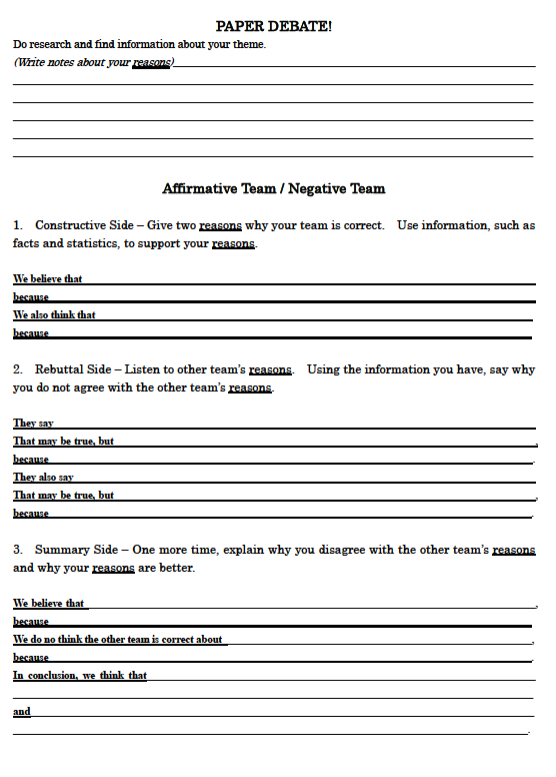PAPER DEBATE. Classroom Activities to Reinvigorate Senior High School Language Learning
PAPER DEBATE

Classroom Activities to Reinvigorate Senior High School Language Learning
In the dynamic world of senior high school language teaching, keeping students engaged and motivated is often a thrilling challenge. As educators, we understand that the key to successful learning lies in creating an atmosphere where students are not just participants but active enthusiasts. Here are some classroom activities designed to ignite the language classroom, bringing energy, excitement, and enthusiasm to senior high school students. From interactive games to creative exercises, we’ll delve into ways to make language learning an enjoyable and enriching experience.





PAPER DEBATE
Target Group: 1st year
Difficulty Level: Basic Conversation
Activity Objective: Show students the building blocks of debate, how each is applied and its intended purpose
PAPER DEBATE – Procedure
Students are directed to form pairs or small units. All units will work simultaneously for a determined amount of time. Each unit of students will be working with two other units of students. Each unit brainstorms a debate topic providing two reasons supporting or opposing their viewpoint. The second unit receives the first units’ debate topic and reasons. They support the contradictory viewpoint and provide two reasons for their viewpoint. The third unit will review the supporting and opposing viewpoints and explain which has the most well formulated reasoning.
This break-down of debate roles helps students understand each role and the function it serves in a debate.
Materials and Preparation
Creating Support for a Debate Topic – The top third of the worksheet will be used by the first unit of students to write their debate topic and two reasons supporting their viewpoint.
Creating a Rebuttal to a Debate Topic – The middle third of the worksheet will be used by the second unit of students to write their contradictory viewpoint and two reasons supporting their viewpoint.
Evaluating the Debate – The last third of the worksheet will be used by the third unit of students to review the supporting and opposing reasons and determine the best constructed reasons.
Each unit of students will play a supporting, opposing and reviewing role in this activity. This exercise allows the groups to practice the application of knowledge to the debate process.
Each unit of students will receive one worksheet. The student unit will work together to decide a debate topic and create two reasons supporting their debate topic. When they are finished they will pass their worksheet to the second student unit. This second unit will review the product of the first student unit and create a contradictory viewpoint. The second student unit will write their contradictory viewpoint and reasons on the same worksheet. After they are finished, the second unit will pass the worksheet to the third student unit. The third unit will review the debate topic and its supporting and opposing viewpoints and reasons. When the third unit has finished writing their judgment and their reasons for selection, they will pass the worksheet back to the first unit.
Each student unit now has its original worksheet containing their starting debate topic and reasons, the second unit’s contradictory viewpoint and reasons and the third unit’s judgment and reasons.
Each student unit will be asked to evaluate their work and the work of their debate partners. The review process helps students to identify their strengths in debate and areas of improvement.


Suggestions and Advice
Students should have prior experience with the concept of debates. Previous lessons explaining how to create reasons and the differences between strong reasons and weak reasons will help students work more confidently. This activity does not require students to have an extensive
vocabulary as the purpose is to conceptualise a debate. You should be very forgiving of poor grammar and mistakes. Creating strong logical reasons in a foreign language is demanding enough without adding further grammatical scrutiny.
Some students will grasp the debate idea easily, while others will struggle. Pair students with a firmer understanding with students who might need more help. Allow students to work at a slower pace so they are better able to absorb the content. The activity should conclude with a review of each part of the debate and examples from other students.





Classroom Activities to Reinvigorate Senior High School Language Learning
As we conclude this exploration of classroom activities to energize the language class for senior high school, we’ve witnessed how a well-crafted lesson plan can transform a mundane classroom into a vibrant hub of learning and creativity. These activities not only boost language skills but also foster a sense of teamwork, critical thinking, and cultural appreciation. By implementing these engaging methods, educators can ensure that their senior high school students are not just fluent in the language, but also passionately engaged in the journey of language acquisition.
So, let’s continue to infuse our classrooms with energy, enthusiasm, and a love for language, empowering our students for a brighter future.





Also check out these articles on teaching, teaching methods and teaching tools
















